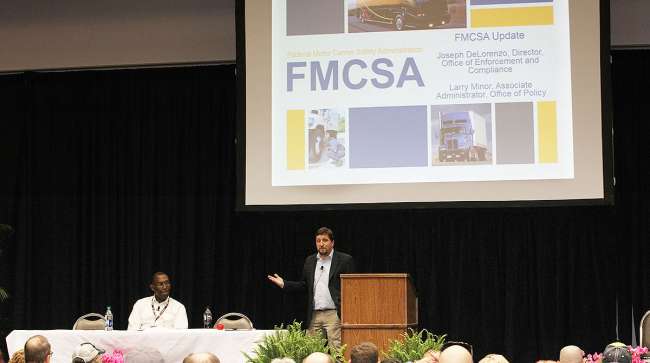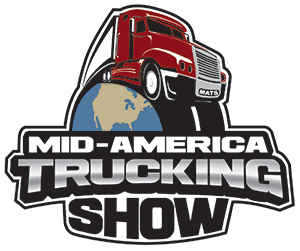Senior Reporter
FMCSA to Drivers: Don’t Overthink Personal Conveyance Time

LOUISVILLE, Ky. — Some truck drivers still are grappling with the definition of personal conveyance time. They shouldn’t be, according to a top executive for the Federal Motor Carrier Safety Administration.
Here’s a simple way to evaluate whether a driver is on personal conveyance time, according to Joe DeLorenzo, FMCSA’s director of enforcement and compliance: “Am I off duty? Am I doing any work at the request of the motor carrier, rather than for myself? Is the major purpose of why the motor vehicle is being moved personal? Is it for a nonbusiness-related purpose?”

Joseph DeLorenzo by John Sommers II for Transport Topics.
DeLorenzo gave those words of advice during an electronic logging device update session at the Mid-America Trucking Show here March 30.
Although DeLorenzo was offering a variety of tips about steering clear of trouble using the devices, it was personal conveyance time — also known as authorized personal use time — that garnered the most questions from drivers.
Some common examples of personal conveyance time include time spent traveling to lodging, restaurants or entertainment venues, time spent traveling to a reasonable, safe location to obtain required rest or moving a truck at the request of a safety official during the driver’s off-duty time, DeLorenzo said.
A driver cannot use the time for the sole purpose of advancing the freight or time spent transporting a vehicle to a facility for maintenance, he said. There are no specific time or distance limits for legitimate personal use movement of commercial motor vehicles.
“It doesn’t matter what you’re hauling or whether you’re loaded or unloaded or hooked up to a trailer or not,” DeLorenzo said. “You can move the vehicle to the nearest safe location on personal conveyance time to get rest, and you don’t have to go backwards. This is one of those times where it’s OK to continue on the progress of the load as long as you are stopping at the nearest reasonable, safe location. We deliberately don’t define that because that’s a judgment call on the part of the driver.”
He added, “We don’t want a driver parking in a lot that doesn’t have any lighting or any protection. We don’t want anybody parking on the side of the highway where it’s unsafe. You can make the call.”
When it comes to the use of ELDs, DeLorenzo said drivers foremost need to know whether they are using automatic onboard recording devices or ELDs during roadside inspections.
One of the more common violations regarding both ELDs and AOBRDs involved drivers not knowing how to transfer data to roadside inspectors.

In our season 2 second episode of RoadSigns, we ask: What does the future hold for ELDs? Hear a snippet from Norm Ellis, president of EROAD, above, and get the full program by going to RoadSigns.TTNews.com.
DeLorenzo encouraged carriers using AOBRDs to make the transition to ELDs now rather than waiting to meet the Dec. 16 deadline at the last minute.
“It’s human nature to procrastinate to the last minute,” he said. “Please take the time and talk to your providers right now.”
While there have been rumors that the use of ELDs was causing more speeding violations to be written, FMCSA records indicate there has been only a slight bump in speeding violations in recent months. “There are a couple of little tiny spikes,” he said. “But generally, I think it hasn’t been as bad maybe as some people think.”
DeLorenzo added, “In terms of ELD compliance, things are going fairly well. Of roadside inspections, there are only about 1% that are getting cited for having no ELD.”



